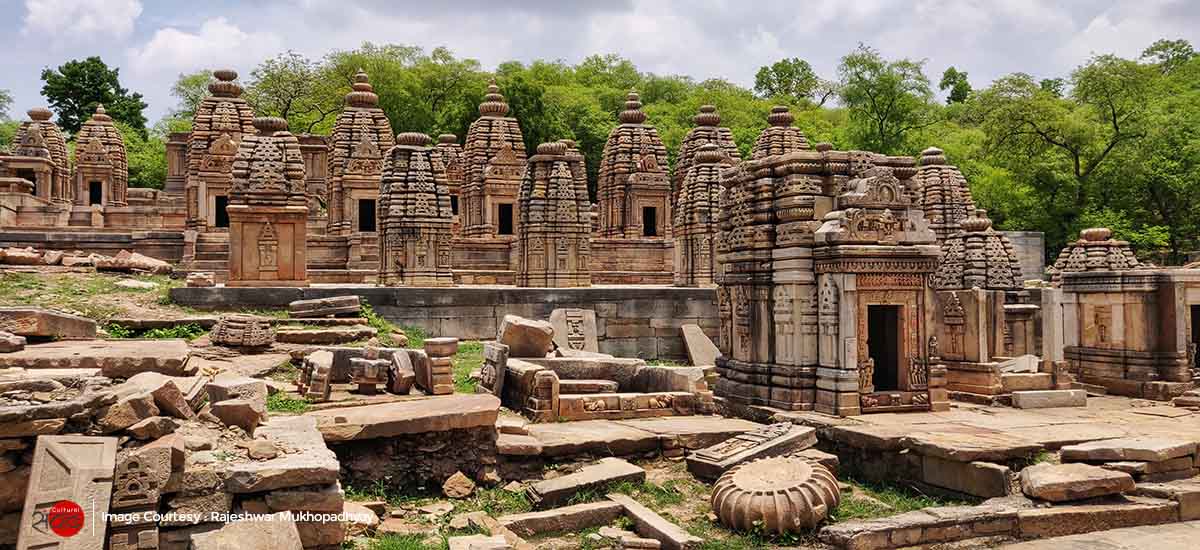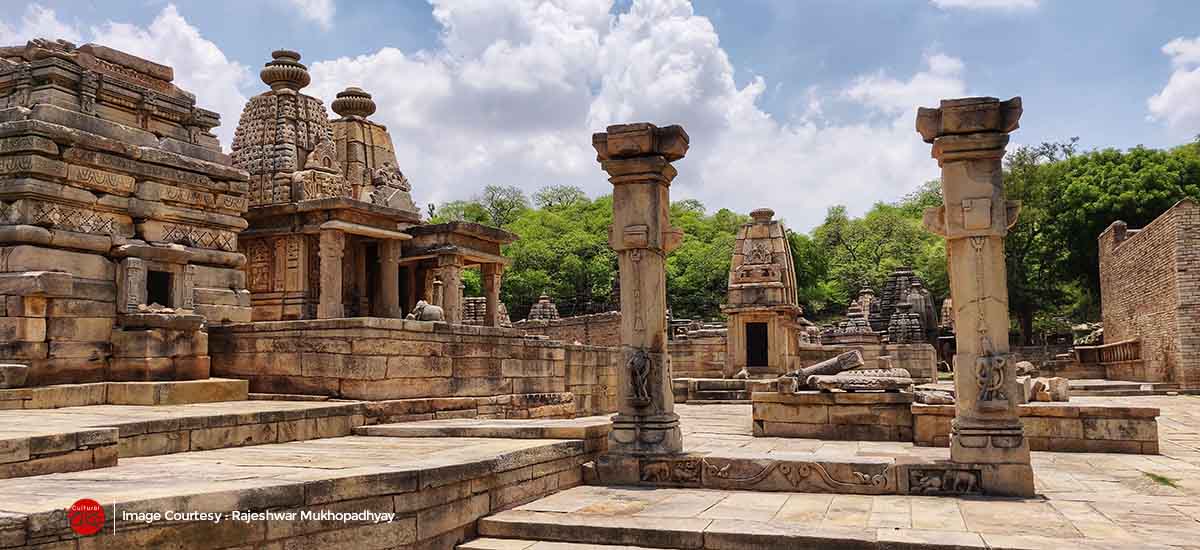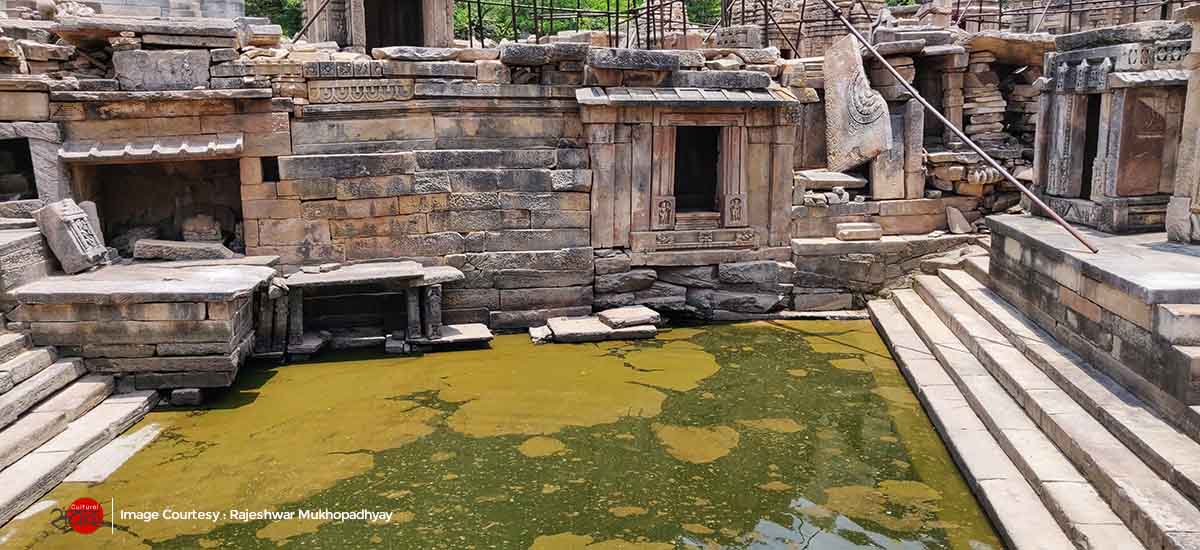The guns have fallen silent. The dacoits are long gone. The mesmerising valleys of Chambal no longer evoke fear but beckon the traveller with enchanting tales of yore and their long-forgotten heritage.
Not far from Gwalior, in the Morena district in Madhya Pradesh, lies a vast and stunning temple complex of ~200 temples in various stages of repair and disrepair. This temple complex spread over 25 acres (10 hectares) is commonly referred to as the Bateshwar group of temples and is probably one of the largest extant group of temples in India.

A Short History of the Bateshwar Temples… A Tale spread over 14 Centuries…
The Bateshwara temples built over a period of a few centuries (8th to 12th centuries CE) are attributed to the Gurjar-Pratihara dynasty. While the complex has shrines dedicated to all three major deities in the Hindu tradition – Shiva, Vishnu and Shakti; the Bateshwar complex in all likelihood derives its name from the main shrine dedicated to Bhooteshwara or Bhuteshwara (a name for Shiva – the lord of ghosts).
The continuity of architectural activity over hundreds of years and the size of the complex undoubtedly suggest that the shrines were popular in their heyday. However, the Bateshwar temples started fading into the depths of the ravines of the Chambal valley somewhere in the 13th Century CE. The reasons for this decline are not well understood. The renowned archaeologist – Padma Shri K. K. Muhammed is of the opinion that a combination of an earthquake and human neglect seem to be the most plausible causes of the decline.

In the 19th century CE, Alexander Cunningham recorded the existence of a group of 100 small temples in Padavali (Paravali) or Dharon (old name of the area). He mentioned that only a handful of these temples were in a fair state of repair and described the Bhooteshwara temple as a ‘very fine old temple’ and in some bit of detail.
Bateshwar was notified as a protected site by the Archaeological Survey of India (ASI) only in the early years of the 20th century CE (1920). However, work on the restoration of the site began only in the 21st century CE.
In 2005, ASI embarked on an ambitious programme to restore some of the temples to their former glory under the stewardship of Shri K.K. Muhammed, the then Superintending Archaeologist of ASI’s Bhopal region. He and his team not only drew upon the principles enunciated in the centuries’ old Sanskrit texts of Manasara Shilpa Shastra and Mayamata Vastu Shastra to help in rebuilding the lost temples from the ruins but also enlisted the support of the local dacoits. Padma Shri K.K. Muhammed and his team’s labour of love as they virtually reconstructed the shrines is one of the golden pages in the long story of Indian archaeology.

The Bateshewar Temples – Few Notes on Architecture and Sculpture
An eminent scholar and expert on Indian Temple Architecture, Michael W. Meister, noted that most shrines of the Bateshwar complex are of the ‘mandapika’ type while some temples also have ‘nagara’ shikharas superimposed on them.
The Bateshwar temples are characterised by exquisite carvings and bas reliefs on a diverse range of subjects from the Kalyana Sundaram of Shiva and Parvati with Brahma and Vishnu in attendance to an affectionate Devaki feeding her little Krishna in jail. From Lakulisa, Nandi and Nataraja to the Dasha-avataras and the Saptamatrikas and from amorous couples and female musicians to men riding elephants and horses, the sculptors were true to the grand Indian tradition of temple architecture.

Will the Bateshewar Temples live to tell their tale for the next 14 centuries?
Thanks to the efforts of the ASI and the support of erstwhile dacoits, politicians and locals, parts of the Bateshwar temple complex have been restored to their former glory. However, the complex is still strewn with pillars, shikharas and sculptures waiting to come together in harmony. It is also an open secret that the temples are under threat from multiple quarters. Limited funding, the mining mafia and our widespread apathy to our own crumbling heritage are probably some of the better-known threats.
Depressing as it may sound, the danger that the Bateshwar temples may not live to tell their tale for the next 14 centuries is very real. The least that we can do as Indians, is to appreciate our own tangible heritage and wake up to the gargantuan issue of protecting our cultural marvels for generations to come.
Do not give the Bateshwar temples in the heart of the Chambal valley a miss on your next trip to Gwalior, Madhya Pradesh or better still, plan a trip to experience their sublime charm.
Editor’s Notes:
- This note was inspired by a friend who is an avid traveller and an ace photographer – Rajeshwar Mukhopadhyay. All images used in this article (except Cunningham’s map) have been shot and handpicked by him.
- We have not delved into the details of ‘mandapika’ and ‘nagara’ styles of temple architecture. Meister’s article mentioned in the references has details of the ‘mandapika’ style of temple architecture.
- You can watch Shri K.K. Muhammed narrating the riveting story of Bateshwar and its restoration in this video. https://youtu.be/kaNPeCzbSpM
- Read about the forms of Shiva in our piece on the formless Shiva.
References:
- Meister, Michael W. “Construction and Conception: Maṇḍapikā Shrines of Central India.” East and West, vol. 26, no. 3/4, 1976, pp. 409–418.
- Cunningham, Alexander. “Report of a Tour in Eastern Rajputana – Volume XX”. Archaeological Survey of India. Retrieved from archive.org.
- https://frontline.thehindu.com/static/html/fl2702/stories/20100129270212200.htm
- http://www.mptourism.com/sites/default/files/traveltools/Gwalior_0.pdf
- https://www.outlookindia.com/magazine/story/india-news-gabbar-roars-again-save-chambals-angkor-wat-pleads-former-dacoits-family/302142
Team Cultural Samvaad is on a journey of trying to re-discover unique Indian idioms which are the cornerstones of this ancient civilisation and have the power to shape the glorious future that beckons Indians. If you have any comments or suggestions or would like to share stories and/or audio-visuals that will help our readers in understanding and appreciating the multi-coloured hues of Indian culture, please do write to us at [email protected].


What a Treasure! Used to travel in those areas Bhid ,Morena and the Behars of Chambal by car a lot in the seventies.Wish had knowledge about this treasure trove then.Now will have to be happy seeing pictures .A beautiful restoration work by ASI.
That must have been beautiful Ms. Bose. Yes, wonderful work by ASI. Thanks for stopping by and commenting. Hope to see you again.
What a wonderful way to revive Indian culture and heritage sites. The photos are breathtaking. Thank you Garima and Rajeshwar for sharing and bringing these gems to the fore with the story telling and curated pictures.
Thanks a ton for your encouragement Bilwa.
Great work done by the team. Thanks ASI and the whole team to restore this heritage.
Wonderful information and great photographs. Thanks Garima and Rajeshwar..Keep it up..